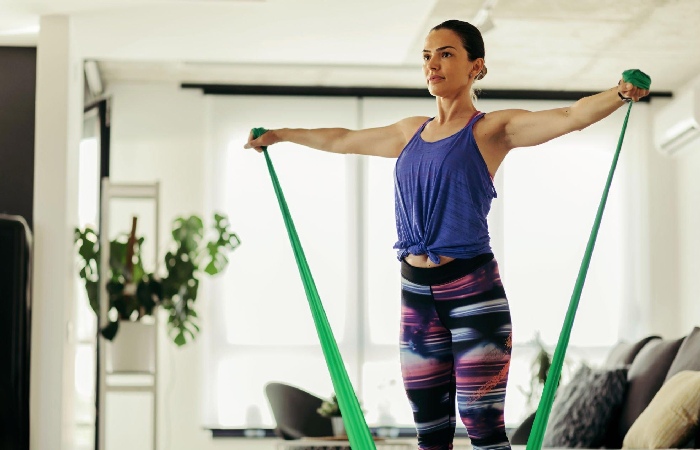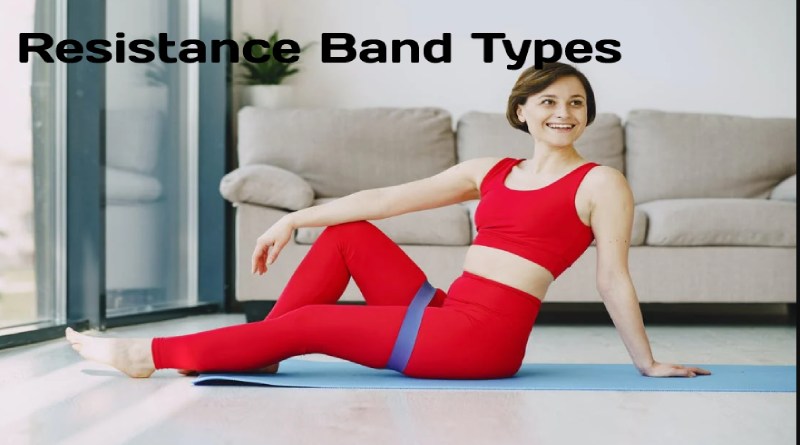Table of Contents
Definition of Resistance Bands

Resistance bands are a type of elastic band will use for strength training. It is also extensively will use in physical therapy, particularly by convalescents with muscle injuries, including cardiac rehab patients, to allow gradual strength regeneration.
Resistance bands range from simple flat therapy bands to elastic tubes with interchangeable straps, making them more user-friendly.
Choose A Series Of Bands With Various Resistances Voltage Levels
- Because the bands are usually colour coded, the voltage rises as the colours become darker. Therefore, the more strength required for an exercise, the more resistance the band will provide. A chest press, for example, will require more tension than a bicep curl. However, if you add too much resistance bands, you will not have a smooth range of motion.
- Consider the accessories that come with the bands, such as door accessories or anklets, and match them to the exercises you intend to perform.
- When using resistance bands, you should also wear sneakers. Also, when connecting a band to a port, please give it a good tug before exercising to ensure it’s secure.
4 Straightforward Resistance Bands Exercises
It will suggest that you do two sets of 15 repetitions of each of these exercises once a day, at least two days a week:
-
Breastplate: Resistance Bands
Wrap the resistance bands around your back, holding both ends in place. Push the band forward as you straighten your elbows and hold for a second; begin through your arms by your edges and your elbows bent.
-
Legs: Resistance Bands
Grip equally ends of the band with your hands while standing on top of it. Next, bend your knees, squat while holding the bar, and extend your knees to stand. Repeat the process.
-
Biceps (arms):
While standing, the resistance bands should step on the band and lift your arm by bending your elbow and holding your hands towards you and have the pan for one second. Always keep your arms facing upwards
-
Triceps (arms):
Connect the resistance bands to a port securely. Spread your hands apart while bending your elbows while holding the band. Maintain a close grip on your elbows.
Resistance Bands Types

- Therapy bands
- Lit loop bands/mini
- bands Figure 8
- Tube bands/compact resistance bands
Why Are Resistance Bands Helpful To Bodybuilding?
The fundamental distinction is that the resistance of elastics rises as the band stretches, but the opposition of weight remains relatively constant. therefore, it is advantageous for bodybuilding s
It will refer to as variable linear resistance. According to research, including elastics into your weight training regimen (alone or in conjunction with free weights) can significantly improve force and power more than simply utilising weights.
Exercise bands may also give resistance from any angle, making them great for targeting tiny groups of muscles, which is crucial for competitive bodybuilding.
4 Shoulder Pain Exercises using Resistance Bands
Below is an explanation of how to reduce shoulder pain with resistance bands to reduce shoulder pain and strengthen the shoulder muscles through four exercises.
- Hand Internal rotation
- Underhand pull aparts
- Lateral Raise
- Lying External Rotation
Resistance bands come in several varieties that can use for various exercises.
The 8 Best Resistance Bands Exercises
Resistance bands are probably the best low-cost training accessory available on the market. Also known as elastic bands, they are for beginners and people already advanced in fitness. Adding elastic bands to your workout increases muscle effort because of the added resistance bands. Another benefit is using elastic bands to work small muscles as stabilizers.
-
Sidewall Pulled Down
Place your back against a wall. Place the elastic band between your thumbs or wrists and raise your arms over your head. Pull your arms down, elbows to the side, producing a 90-degree angle. As a result, the elastic band will stretch, pushing your shoulder blades closer together. Return to the starting position.
-
Extension Of Triceps
Place yourself on a chair, on a step, or your heels. Pass the elastic band beneath your right knee while gripping the other end with your right hand. Overcome the resistance bands of the rubber band by bringing your right hand to your right shoulder. When tugging the band, the upper arm must stay immobile. The elbow is near to the body and angled towards the shoulder. Return to the beginning position by lowering your forearm. Perform complete repetitions on one side before switching.
-
Hydrant
On your knees and wrists, support your body. Place the resistance band about above your knees. The neck, back, and hips should all be in alignment. Stretch the band by extending your left leg. Do not turn to the side with the rest of your body. Return to the starting point. Perform complete repetitions on one side before switching.
-
Buttons 4 Supports
On your knees and wrists, support your body. Should wear The resistance band above the knees. The neck, back, and hips should all be in alignment. Stretch the elastic by making a “kickback” motion with your left heel. Keep your hips in line and your back straight. Return to the starting point. Perform complete repetitions on one side before switching.
-
Side Plank Modified With Leg Lift
As though you were about to execute a side plank, position yourself. Bend your left leg while keeping your right leg straight, so your left elbow, knee, and right foot are on the floor. Position the resistance band over your knees. Lift your right leg, defying the rubber band’s resistance band. Maintain your posture and engage your glutes. Return to the starting point. Perform complete repetitions on one side before switching.
-
Leg Lift On High Plank
Put your hands and feet on the floor in a high plank stance. Hands should be precisely beneath the shoulders, and the body should be straight from head to heels. Wrap a resistance band around your ankles. Engage your abs and glutes. Then, overcoming the pull of the rubber band, elevate your left heel. Maintain a straight body and avoid bending your back. Return to the starting point. Perform complete repetitions on one side before switching.
-
Squat With Leg Raising
Should wear the resistance band above the knees. Upon returning to your starting position, squat then elevate your right leg laterally, squeezing the outside of your glutes. Then return to squatting. Alter the portion used with each repetition if you like.
Conclusion
Most of us can not go to the gym and exercise because our busy life membership is heavy, so it is very easy to use resistance bands at home.
Also Read: Sleep Deprivation –Definition, Causes, Disadvantages, And More
Related posts
Featured Posts
What are the 18 Best Skincare Products In 2024?
Introduction Best Skincare Products Which are the best skincare products in 2024? This article shows some of the best skin…
Best Fitness Brand on Social Media
Fitness Brand on Social Media: Workout gurus and yoga influencers may find on Instagram in all corners. So what are…


